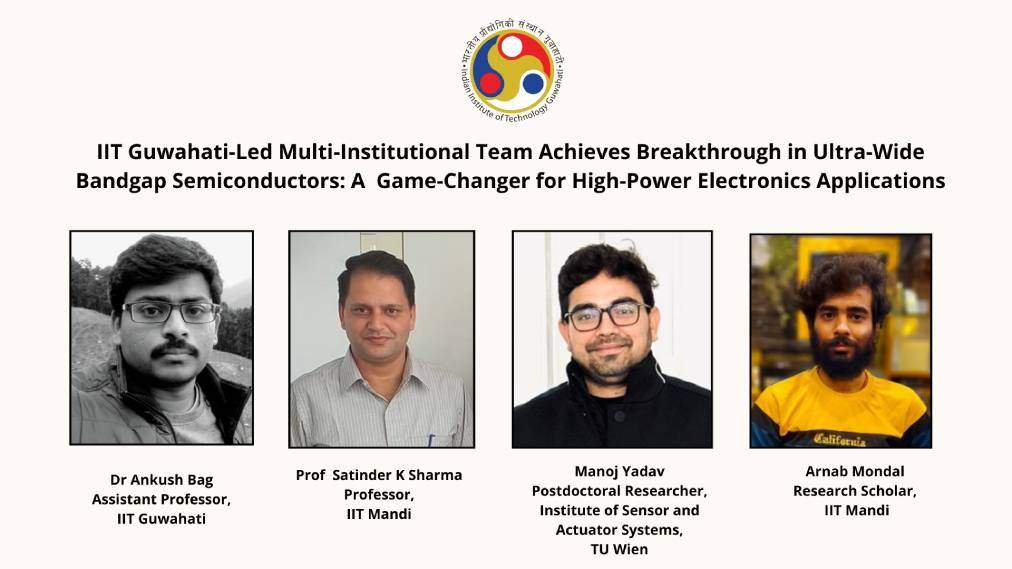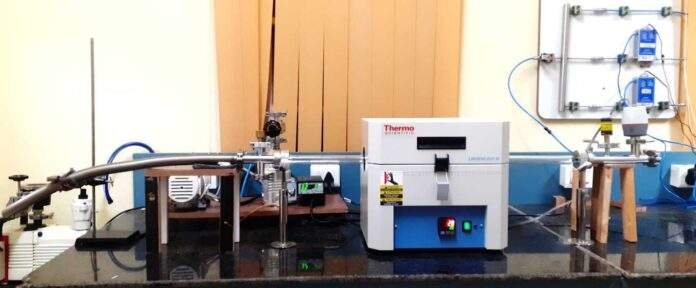A groundbreaking achievement in semiconductor technology has been unveiled by a collaborative research effort led by the Indian Institute of Technology, Guwahati (IIT Guwahati). Headed by Dr. Ankush Bag, an Assistant Professor in the Department of Electronics and Electrical Engineering and the Centre for Nanotechnology, the team, in partnership with IIT Mandi and the Institute of Sensor and Actuator Systems at Technical University Wien, has successfully developed a cost-effective method to grow a specialized semiconductor.
IIT Guwahati-Led Team Pioneers Breakthrough in Ultra-Wide Bandgap Semiconductors
This newly developed Gallium Oxide Semiconductor holds immense potential for revolutionizing high-power electronics applications, particularly in enhancing the efficiency of electric vehicles and high-voltage systems. The innovation is expected to address critical challenges, making high-power devices function efficiently even in extreme conditions, such as temperatures reaching 200 ºC.

The researchers achieved this milestone through an innovative and cost-effective approach to grow ultrawide bandgap semiconducting material, named gallium oxide, using a custom-designed low-pressure chemical vapor deposition (LPCVD) system. Dr. Ankush Bag emphasized the significance of their research, stating, “Power semiconductor devices are the heart of every power electronic system, and for emerging high-power applications, there is a demand for compound semiconductor materials with an ultra-wide bandgap.”
Power electronic systems play a pivotal role in managing and controlling the flow of electricity, converting energy from both renewable and non-renewable sources into a form compatible with end-user applications. The new semiconductor material is expected to outperform existing solutions like Gallium Nitride (GaN) and Silicon Carbide (SiC), especially in high-power applications where cost limitations were a concern.
Dr. Ankush Bag elaborated on the challenges faced during the research, highlighting the need to create thin and smooth films from the gallium oxide material. After multiple trials and rigorous study, the team successfully optimized the gallium oxide semiconductor, incorporating tin to improve and modulate its conductivity. The resulting ultra-wide bandgap compound semiconductors have been successfully fabricated into two-terminal devices, with applications spanning electric vehicles, high-voltage transmission, traction systems, and industrial automation.
What sets this research apart is the shift from the common use of Gallium oxide substrates to a sapphire substrate, enhancing cost-effectiveness and thermal performance. This departure addresses issues related to the expense and poor thermal conductivity associated with traditional Gallium oxide substrates.
The findings of this groundbreaking study have been published in multiple research papers in prestigious journals, including the IEEE Transactions on Electron Devices and Thin Solid Films. The collaborative effort involved researchers like Dr. Satinder K. Sharma and Mr. Arnab Mondal from the School of Computing and Electrical Engineering at IIT Mandi, and Mr. Manoj K Yadav from the Institute of Sensor and Actuator Systems, TU Wien, Vienna, Austria, along with Dr. Ankush Bag from IIT Guwahati.
This pioneering research has received vital funding from the Science and Engineering Research Board (SERB), Department of Science and Technology, marking a significant leap forward in the field of high-power electronics. The breakthrough is expected to have far-reaching implications for the technology landscape, particularly in advancing the capabilities of high-power electronic systems.
About IIT Guwahati:
Established in 1994, the Indian Institute of Technology Guwahati completed its 25th year in 2019. The institute boasts eleven departments, nine interdisciplinary academic centers, and five schools covering major engineering, science, healthcare, management, and humanities disciplines. IIT Guwahati has consistently ranked among the top engineering institutions in India and has achieved notable global recognition for its research and academic endeavors.
The institute remains at the forefront of critical research initiatives, including Genomics, Developmental Biology, Health Care, Bioinformatics, and Flexible Electronics. It has retained its position among the top engineering institutions in India, securing the 7th position in the ‘India Rankings 2023’ declared by the National Institutional Ranking Framework (NIRF) of the Union Ministry of Education.
For further information, please contact:
Media Contact for IIT Guwahati: Bhavani Giddu – Footprint Global Communications Cell: 9999500262 / Email: bhavani.giddu@footprintglobal.com Akhil Vaidya – Footprint Global Communications Cell: 98821 02818 / Email: akhil.vaidya@footprintglobal.com Sudeshna Gupta – Footprint Global Communications Cell: 91019 06449 / Email: sudeshna.gupta@footprintglobal.com Anurupa Devi – Footprint Global Communications Cell: 60016 99065 / Email: anurupa.devi@footprintglobal.com











